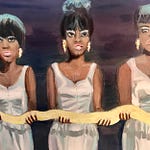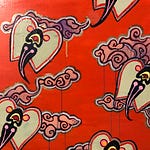1901, the year that Bergdorf Goodman first opened its doors, was, like most fins de siecle a time of upheaval, confusion, and progress. Technology revealed such playthings-for-the-wealthy as the first Oldsmobile (a steal at $650). “Pax 1901,” the Buffalo Pan-American Exhibition, was a celebration of America’s international dominance over Mexico, Hawaii and the Philippines, the future of space travel, and fabulous re-enactments of disasters like the Johnstown Flood and the Chicago Fire. “Americans, it seemed, already had an appetite for sensational misfortune reworked as entertainment,” wrote popular historian Charles Panati. Fair-goers were also able to witness a real-time misfortune when President McKinley, shaking hands with a line of admirers, was assassinated point-blank by an anarchist. Queen Victoria also died in 1901, thus drop-kicking the sartorial Victorian Era into the Edwardian Era.
The typical, upper-class late-Victorian, early-Edwardian woman (the Lady Who Lunched 111 years ago) was typically portrayed as an intelligent, devil-may-care and somewhat rebellious creature -- femininity in a latent state of expansion. She yearned to scissor off her corset and breathe freely, stop amputating her toes to fit into narrower boots, and to perform vulgar and shameful acts in the name of health and hygiene, such as bicycling and “animal dances.”
The illustrator Charles Dana Gibson was married to Irene Langhorne --who was considered one of the most beautiful girls on earth, and was the sister of Viscountess Astor. His “Gibson Girls” were considered by some to be the first American fashion icon; but one can certainly draw a line from their absurd fantasy proportions to the hypersexualized Manga females today. Oversize bouffants amplified the Gibson girl’s head; no natural body could mimic the contortions of the fearful S-bend corset, which tyrannized the figure unto a locked-and-loaded type of estrus presentation: inflated, babboon-like derriere, gooseneck waist, and huge, cleavageless ‘monobosom.‘ The Belle Époque was the last era in which the styles of rich ladies were so extremely ostentatious, perversely painful and lavishly detailed. Bridal corsetry in particular, was a sadistic fugue of hand-stitched lace insertions, tucked panels and boning, the complexities of which might discourage the groom on even the most desperately anticipated wedding night.
Hourglass figures would be wrought from chin to foot and down to the end of each wrist in Chantilly lace. Parisian Bonnets with dead birds on them were all the rage -- the annual Easter Bonnet parade was a virtual walking avian genocide. If you were really fashion-forward, you might have half a seagull on your belle chapeau and the better part of an ostrich around your neck. (One can only imagine the size of egg PETA would lay today).
Ladies’ clothing was fairly exorbitant; shoes were $1.50. a skirt might cost $4; a silk petticoat, a whopping $5 -- but lace petticoats were necessary if one was to attract the male gaze while wearing a train or a long skirt, which must be picked up to cross filthy New York streets.
Paris, naturally, was the wellspring from which all posh fashion sprang -- Paul Poiret was the most celebrated, talented and audacious designer of his time. His fearless vision really épater'ed the bourgeoisie of the Belle Époch, drawing his inspirations straight from the artistically unfettered Ballet Russe of Sergei Diaghilev. The shocking exoticism of the Orient was thus injected into Paris fashion -- with all the harems, Geisha-girls, peasant boots, turbans with feathers, and loose sexual promise they represented. Downton Abbey fans will remember the moment when Lady Sybil scandalizes her immediate family by appearing in a new outfit -- a scandalously corset-free, ankle-exposing, Poiret-inspired set of harem pants.
When Poiret presented what was to become his most celebrated contribution to the fashion world -- the kimono-coat -- to Russian Princess Bariatinsky, she reportedly cried, "What a horror! When there are low fellows who run after our sledges and annoy us, we have their heads cut off, and we put them in sacks just like that."
As the Edwardian Era kicked in, women’s clothing took a turn for the considerably more blousy -- the tonneau or barrel silhouette brought about a rather large and sagging look about the chest, which was allegedly inspired by Edward VII’s preference for older, larger, more bosomy women. (In the early oughts, Sigmund Freud had already told America that the sex-drive was the engine of all human character and endeavor -- advertising would soon abolish such an easily and naturally accomplished style of beauty).
New York society ladies were a headstrong crew of broads. They loathed the nouveau riche, believing it more virtuous to inherit money and good breeding than to have earned or worked for it -- but they had a keen, if irregular, sense of justice. Uptown ladies formed a vigilante squad, which the press derisively nicknamed “The Mink Brigade,” to stand in picket lines in support of female garment workers after many perished behind locked doors in the Triangle Shirtwaist Factory Fire. (Their altruism, however, only extended only so far -- they objected to young ladies being set on fire, but they were still opposed to trade unions).
World War One would kill off the Gibson Girls, and the last vestiges of Victorian style; Socialist tendencies tamped down styles into more democratic and workable forms. But in a few ways, 1901 is still evident on Fifth Avenue -- there will always be ladies who lunch, and some boutique will always sell intricate, rib-cracking, organ mangling corsets -- if only to the most nostalgic of serious perverts.
Con
Contact me for any and all of your editing needs: cintraw@gmail.com
Artwork: “Her Late Parents,” oil on linen, Cintra Wilson 2021












